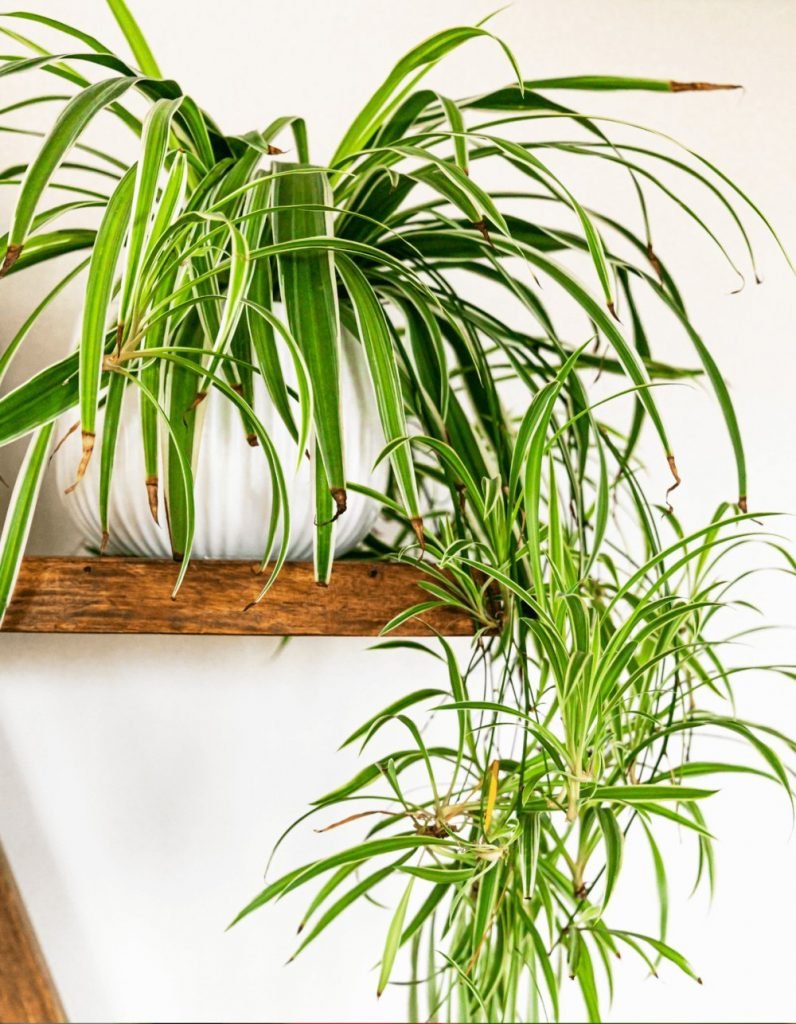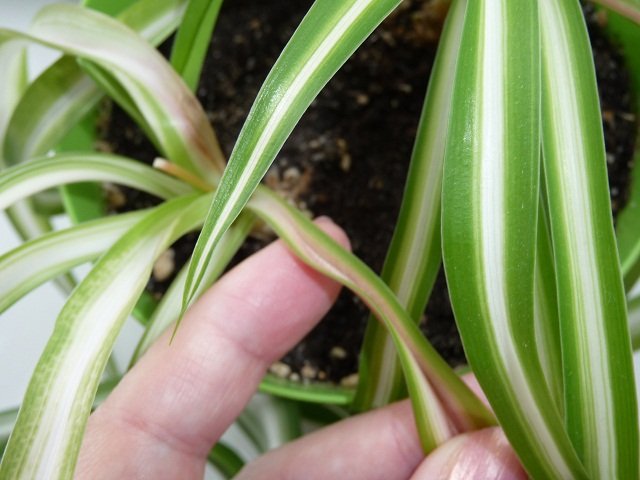Spider plants, or Chlorophytum comosum, are renowned for their resilience and ease of care, making them a staple in the realm of indoor plants. However, even the hardiest plants like spider plants can encounter issues, one of the most common being brown tips on their leaves. Understanding the reasons behind these brown tips and knowing how to address them can help keep your spider plant healthy and thriving.

Why Do Spider Plant Leaves Develop Brown Tips?
Too Much Direct Sunlight
While spider plants enjoy bright light, they can suffer from leaf burn if exposed to too much direct sunlight. This is often noticeable when the tips of the leaves start turning brown. Moving your plant to a spot with indirect light can prevent further damage.
Humidity Levels Are Crucial
Spider plants thrive in environments with moderate to high humidity. Dry indoor air, especially in homes with central heating or air conditioning, can lead to brown leaf tips. Increasing humidity around your plant can be achieved by grouping plants together, using a humidity tray, or placing the plant in more humid areas like kitchens or bathrooms.
Watering Woes: Over or Under
Both underwatering and overwatering can cause brown tips on your spider plant. The plant’s soil should be kept evenly moist but not soggy. Ensure proper drainage to prevent excess water from causing root rot. Conversely, if the soil becomes too dry, the plant may start turning brown due to lack of water and nutrients.
Fluoride Sensitivity
Spider plants are sensitive to fluoride, commonly found in tap water. Using tap water to water your spider plant can lead to a buildup of fluoride, causing the tips of the leaves to turn brown. Using distilled water or rainwater can prevent this issue.
Fertilizer: A Double-Edged Sword
While feeding your spider plant is essential for its growth, over-fertilization can harm the plant. Excessive fertilizer can damage the roots and cause the leaf tips to brown. It’s crucial to fertilize sparingly and flush the soil periodically to prevent fertilizer buildup.
Reviving Your Spider Plant with Proper Care
Identify the Cause First
Before taking any action, it’s important to identify the reason your spider plant has brown tips. Check the plant’s environment, watering schedule, and fertilization routine to pinpoint the cause.
Trimming Affected Leaves
Carefully remove dead parts of the leaves with sterilized scissors to prevent infection. When trimming, avoid cutting the leaves at an angle, as this can open up more of the leaf to air and potential pathogens.
Adjusting Watering Habits
Regularly check the spider plant’s soil and adjust your watering schedule based on soil dryness. The goal is to keep the soil moist but not waterlogged. Also, consider the type of water you’re using. If you suspect fluoride is the issue, switch to distilled water or rainwater.
Reassessing Plant Location
If direct sunlight is the culprit, move your plant to a location where it will receive bright but indirect light. This can prevent further scorching of the leaves.
Humidity Solutions
To increase humidity around your plant, consider placing it in a room with naturally higher humidity, like a bathroom or kitchen. Alternatively, you can use a humidifier or place the plant on a pebble tray filled with water.
Reevaluating Fertilization
Fertilize your spider plant sparingly, using a balanced, water-soluble fertilizer. Over-fertilization can lead to salt buildup in the soil, causing brown tips. If you suspect over-fertilization, flush the soil with water to remove excess salts.
Common Spider Plant Varieties and Their Care
Spider plants come in various types, each with its unique charm. From the variegated leaves of the ‘Variegatum’ to the striking green of the ‘Bonnie’, understanding the specific needs of your spider plant variety can aid in better care and prevention of issues like brown tips.
Repotting for Health
If your spider plant has outgrown its pot or if the soil has become depleted, consider repotting. Choose a pot that’s slightly larger and use fresh, well-draining potting soil. This can rejuvenate your plant and resolve issues related to nutrient deficiencies or poor soil conditions.
While brown tips on your spider plant can be concerning, they usually don’t signify a serious problem. By understanding the causes and implementing the right care techniques, you can prevent and remedy this issue. Remember, the care tips can prevent further damage but won’t revive already browned leaf tips. Regular monitoring and maintenance are key to keeping your spider plant, and indeed any houseplant, in optimal health.

FAQ
1. Why Does My Spider Plant Have Brown Tips?
Browning leaf tips in spider plants can result from various factors, including low humidity, over or under-watering, direct sunlight exposure, fluoride or chlorine in water, or over-fertilization. Identifying the specific cause is key to resolving the issue.
2. How Can I Prevent Brown Tips on My Spider Plant?
To prevent brown tips, ensure your spider plant receives moderate indirect sunlight, is watered correctly (allowing the soil to dry slightly between waterings), and is in an environment with adequate humidity. Also, be cautious with the type of water used and the frequency of fertilization.
3. Is It Normal for Spider Plant’s Leaves to Turn Brown?
While it’s common for the leaves of your spider plant to develop brown tips due to environmental stressors, it’s not a normal condition and usually indicates that some aspect of care needs adjustment.
4. Should I Cut Off the Brown Tips on My Spider Plant?
Yes, you can trim off the brown tips of your spider plant to improve its appearance. Use sterilized scissors and cut straight across the leaf, avoiding any healthy green parts.
5. What Causes the Tips of My Spider Plant to Turn Brown and Then Black?
Brown tips that turn black may indicate severe dehydration or a significant buildup of minerals like fluoride in the soil. Adjust your watering practices and consider using distilled or rainwater.
6. How Often Should I Water My Plant?
Water your spider plant when the top inch of soil feels dry. Overwatering or underwatering can lead to brown tips, so finding a balance is crucial. The frequency can vary based on the humidity and temperature of your home.
7. Can Over-Fertilizing Cause Brown Tips on Spider Plants?
Yes, over-fertilization can cause salt buildup in the soil, leading to brown leaf tips on spider plants. Use a balanced, water-soluble fertilizer sparingly, and flush the soil occasionally to remove excess salts.
8. Why Are the Leaf Tips on My Spider Plant Turning Brown Even with Proper Watering?
If you are watering your plant correctly but still seeing brown tips, it could be due to the quality of water used. Tap water with high fluoride or chlorine content can cause this issue. Try using distilled or rainwater instead.
9. How Do I Know if I’m Underwatering My Plant?
Underwatering is indicated by dry, crispy leaf tips and possibly drooping leaves. If the soil of your plant feels very dry and the leaves are turning brown, it’s likely that your plant needs more water.
10. Can Repotting Help with Brown Tips on Spider Plants?
Repotting can help if the cause is related to soil conditions or if the plant has become root-bound. When repotting, use fresh, well-draining soil and a pot with adequate drainage.
11. What Should I Do with a New Spider Plant That Develops Brown Tips?
For new browning leaf tips in spider plants, assess its current conditions. Adjust lighting, watering, and humidity levels to suit the plant’s needs. Also, ensure the pot and soil provide proper drainage.
12. How Can I Increase Humidity for My Indoor Plants?
To increase humidity, you can mist your spider plant regularly, place it on a pebble tray with water, or use a humidifier. Grouping plants together can also help create a more humid microclimate.
13. Is Direct Sunlight Causing the Brown Tips on My Spider Plant?
Direct sunlight can scorch the leaves of your spider plant, causing the tips to turn brown. Place your plant in a location where it receives bright, indirect light to prevent this issue.
Introduction
Nicki Mann, based in Portland, Oregon, is a good writer and houseplant enthusiast. With her background in environmental science, Nicki specializes in indoor gardening, focusing on sustainable and organic practices.
Experience
Her interest in houseplants began in her mid-twenties, leading to a career writing articles about indoor plant care and eco-friendly gardening for various websites.
Education
Nicki holds a Bachelor of Science in Environmental Studies from the University of Oregon, which underpins her approach to indoor gardening. She continually enhances her knowledge through horticulture and environmental sustainability workshops.
Personal Life
Nicki, an avid nature lover, enjoys exploring the Pacific Northwest's trails. She's active in community gardening and lives with her two rescue cats, who share her interest in her growing collection of houseplants.


